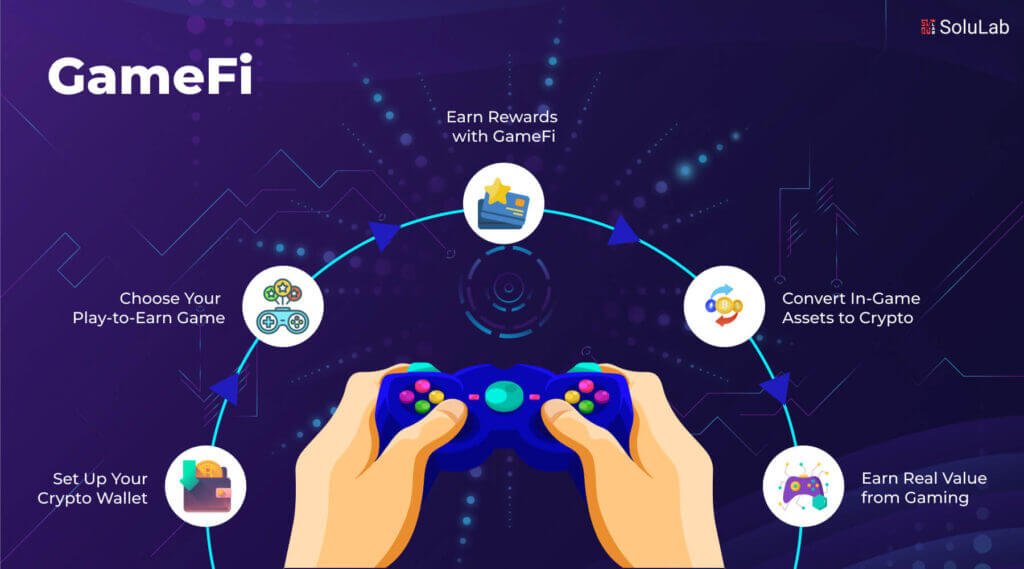GameFi, a dynamic blend of gaming and decentralized finance (DeFi), has emerged as a transformative force in the web3 space by making elements of finance as likeable and engaging as gaming.
This innovative concept leverages blockchain technology to create an ecosystem where users or “players” can earn real-world value from their in-game activities.
Let’s delve into what GameFi is, its origins, its impact on human behavior, and how it has evolved over time.
What is GameFi?
GameFi represents a fusion where game elements meet finance.
At its core, it allows users to earn tangible value by engaging with the product or platform, thus mirroring the principles of DeFi where financial services are available on a public blockchain. This model includes elements such as collectible in-game/in-app assets or even Non-Fungible Tokens (NFTs).
Some of these in-game items possess unique value. They can be owned and transferred to other platforms or products that are part of the ecosystem or to other users using the marketplace.
The Genesis of GameFi
The seeds of GameFi were planted with the advent of blockchain technology and the rise of cryptocurrencies. However, the first breakthrough came with games like “Axie Infinity” in 2018, which popularized the “play-to-earn” (P2E) model.

This game allowed players in less affluent regions to earn a living by playing, showcasing the potential of GameFi to alter economic paradigms within gaming communities.
The term “GameFi” itself gained traction around 2021 as the crypto boom led to an explosion in interest for blockchain-based games. This period saw significant investment in the sector and an increase in games that not only entertained but also offered economic incentives.
Gamified experiences became even more prevalent in 2024 with the launch of Telegram (mini) apps that simplified the requirements in terms of user onboarding, making everyone with Telegram on their phone eligible for participating in the GameFi (r)evolution.
Impact on Human Behavior
GameFi has a profound impact on human behavior, primarily through the concept of gamification and financial incentives:
By integrating financial rewards into gameplay, GameFi increases player motivation. This gamification of finance or financial instruments taps into human desires for achievement and economic gain, leading to higher engagement levels and longer playtimes.
In regions where traditional job opportunities are limited, GameFi has provided an alternative income source. This has led to new behavioral patterns where gaming is not just leisure but a livelihood, influencing how people allocate their time and resources.

GameFi often involves community and guild systems where players collaborate, trade, or compete.
This can lead to new social behaviors, where virtual interactions become economically significant.
In developing countries, people achieved robust incomes by referring others to GameFi apps and platforms.
The volatile nature of cryptocurrencies affects how players perceive risk, turning users into mini-investors. This can influence overall financial behavior, encouraging a more entrepreneurial mindset among users, or making them more adept in web3 by teaching them to use DeFi through the allure of rewards.
Evolution from Past to Present
Initially, GameFi was synonymous with simple P2E mechanics where the primary interaction was battling or breeding digital creatures. However, the landscape has since evolved:
Games have grown in complexity, offering more sophisticated gameplay, better graphics, and intricate economic systems. Titles now often include multiple ways to earn, from land ownership, to completing social tasks, to yield farming within the game’s ecosystem.
Modern GameFi projects increasingly integrate with other DeFi protocols, allowing for more fluid asset management. Players can stake their earnings for additional yield, use assets as collateral in DeFi lending platforms, or transfer their assets to use in other ecosystem products.
As GameFi grows, so does scrutiny. There’s a push towards creating more sustainable models, addressing issues like token inflation, and ensuring fair play. This evolution reflects a maturation in how GameFi games are both developed and played.
Technological Advancements
With blockchain technology’s advancement, issues like transaction speed and cost are being mitigated, enhancing user experience.
The introduction of layer-2 solutions and new consensus mechanisms has made GameFi more accessible and less taxing on resources.
Newer models are even blending GameFi by running parts of it as a traditional web2 product, while the key, blockchain-based elements operate on decentralized networks.
Today, GameFi is not just about earning; it’s about creating immersive, economically interactive worlds. This shift has made finance and gaming a more inclusive and likeable field, redefining human behavior in the digital age.

As we look to the future, GameFi is poised to further integrate with virtual reality, expand into educational games, and perhaps even influence traditional finance by demonstrating new ways of asset management and ownership.
However, creating sustainable GameFi systems seems to be a laborious and time-consuming process for now.
Through much trial and error, we can observe how this blend of gaming and finance will evolve as years or crypto cycles progress.
One of the standout achievements of 2024 was the launch of The Open Network’s infrastructure for Telegram apps, which sparked immense interest in this field and further shaped the environment.
Sustainability has yet to be proven, along with the conscious integration of gamification elements that benefit both users and projects in the long term. So far, we’ve seen numerous short-term, short-lived, money-grab projects which, despite introducing some innovative features, might have done more harm than good in onboarding new users to the GameFi and decentralized finance sectors.
Time will reveal how these practices will be refined in the future.
Much like the dot-com bubble, only those companies focusing on human-centric design and solid principles are likely to succeed long-term, potentially becoming the dominant, blue-chip players we see today, which emerged from the opportunistic bubble at the dawn of the 21st century.